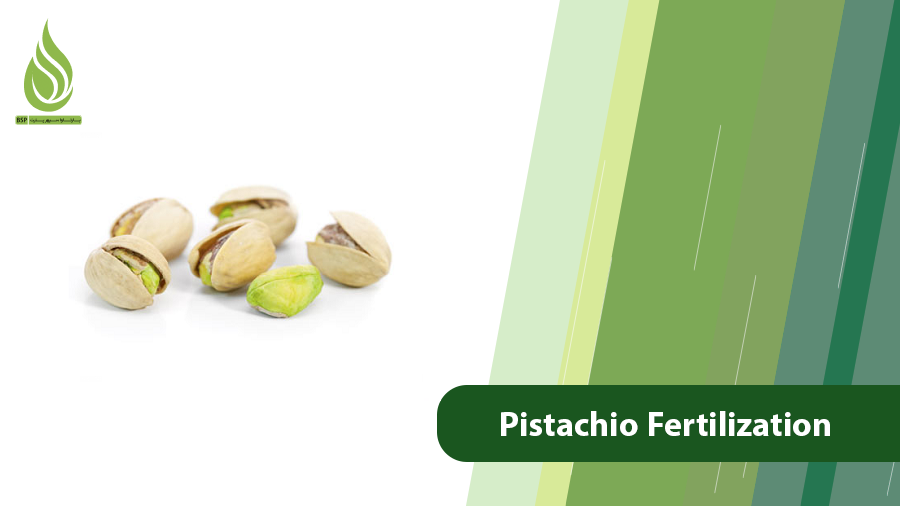
Pistachio Fertilization Program: Essential Nutrients
Pistachios (Pistacia vera) rank among the most valuable nut crops globally, with significant production in regions like the United States, Iran, Turkey, and other parts of the Middle East. The U.S. alone accounts for about 75% of the world’s pistachio supply, with California leading the charge in innovative cultivation practices that emphasize sustainable fertilization to boost yields and quality. This hardy tree thrives in hot, dry climates, making it a staple in arid areas across the Middle East, where water scarcity and soil alkalinity pose unique challenges. Proper fertilization isn’t just about feeding the tree; it’s a strategic approach that enhances growth, improves nut quality, and maximizes economic returns. In this guide, we’ll outline a science-backed fertilization program tailored for pistachio trees. By adhering to a precise fertilization schedule, growers can address common issues like nut blanking, poor kernel fill, and environmental stress resistance.
Why Proper Pistachio Nutrition Matters: A Global Perspective
Pistachios are a strategic crop, valued for their nutritional profile; rich in protein, healthy fats, fiber, and antioxidants like carotenoids and flavonoids. In the Middle East, particularly Iran, which remains a top producer despite climate challenges, pistachios contribute significantly to agricultural economies, with exports supporting rural livelihoods. Pistachio is also a heat resistant tree. a Demand is surging due to health trends. However, without balanced nutrition, trees suffer from reduced growth, empty nuts, fruit drop, and diminished quality; issues exacerbated in hot, saline environments.
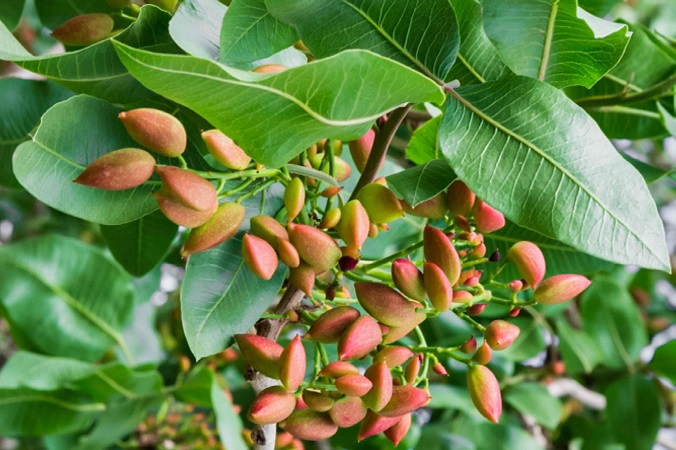
Proper fertilization is the cornerstone of high-yield pistachio farming. Trees have varying nutrient needs throughout the year, influenced by growth stages, soil conditions, and climate. In alkaline soils, nutrient imbalances can lead to deficiencies in iron, zinc, and other micronutrients. Synchronizing fertilizer applications with tree demand is important to minimize waste and environmental impact, such as nitrogen runoff. For instance, in “on” years (high-yield cycles), up to 70% of nitrogen uptake occurs during nut fill, highlighting the need for timed applications.
Investing in a tailored program pays off: Healthy trees resist drought, salinity, and pests better, yielding nuts with superior taste, size, and market value. In regions with limited water, efficient fertilization can improve water use efficiency by 25% through better root development and nutrient uptake. Sustainable practices like these are crucial as production is projected to reach 2.08 billion pounds in California alone by 2031. Ammonium sulfate stands out here, as it not only supplies nitrogen for vigorous growth but also sulfur to lower soil pH, enhancing overall nutrient availability in challenging soils.
Essential Nutrients for Pistachio Trees: Macro and Micro Elements
Pistachio trees require a balanced mix of macronutrients (used in larger quantities) and micronutrients (trace amounts) for optimal health. These elements support everything from root development to kernel quality.
Macronutrients (Primary Elements)
- Nitrogen (N): Critical for leaf and shoot growth, bud formation, and photosynthesis. Deficiencies cause yellowing of older leaves and reduced yields. Mature trees may need 125-150 lbs/acre in heavy fruiting years. Ammonium sulfate is an excellent source, providing 21% nitrogen and 24% sulfur, ideal for alkaline soils where it improves nutrient absorption without causing salt buildup.
- Phosphorus (P): Strengthens roots, aids flower and fruit formation, and enhances energy transfer. Soil tests often reveal needs in phosphorus-deficient areas.
- Potassium (K): Improves flavor, kernel fill, nut splitting (laughing), and stress resistance. Trees respond best when soil K is below 150 ppm. Sulfate forms are preferred over chloride in saline Middle Eastern soils to avoid toxicity.
- Calcium (Ca): Builds cell wall strength, promotes bud growth, and counters physiological stresses like hull rot.
- Magnesium (Mg): Boosts photosynthesis by forming chlorophyll, preventing leaf chlorosis.
- Sulfur (S): Acidifies alkaline soils, reduces salinity, improves drought tolerance, and aids micronutrient uptake. Ammonium sulfate delivers this dual benefit, making it a go-to for pistachio growers.
Micronutrients (Trace Elements)
- Zinc (Zn): Essential for flower bud formation and yield; deficiencies lead to small leaves and poor fruit set.
- Boron (B): Vital for pollination and fruit development; critical in low-boron soils.
- Iron (Fe): Produces chlorophyll; chelated forms are best for high-pH soils.
- Manganese (Mn): Maintains leaf greenness and supports photosynthetic reactions.
- Copper (Cu): Builds enzymes and enhances plant resistance.
- Molybdenum (Mo): Aids nitrogen fixation and uptake.
Pistachio yield depends heavily on mineral uptake, with rapid assessments now available for real-time adjustments. In regions with saline soils, cultivars show tolerance, but balanced micronutrients are key to sustaining production. Foliar applications of chelated micronutrients, applied 3-4 times from April to July, are recommended.
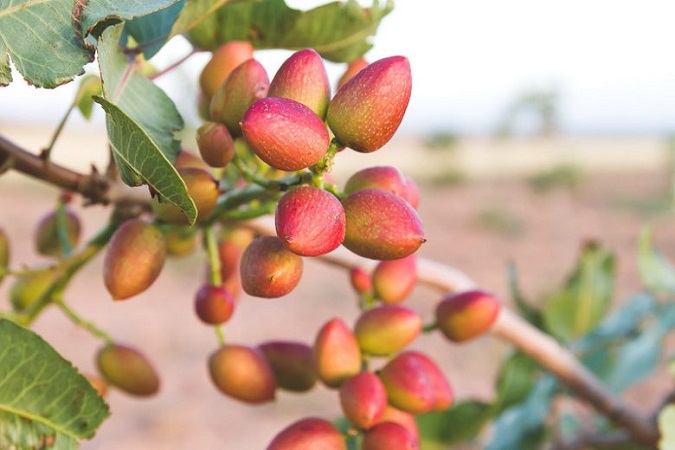
Comprehensive Pistachio Fertilization Schedule: Stage-by-Stage Guide
This program is based on a typical annual cycle, adjusted for worldwide climates, cooler winters in the U.S. and hotter, drier conditions in the Middle East. Timings are approximate (e.g., December-January for winter in the Northern Hemisphere). Always base applications on soil tests. Use fertigation for efficiency in irrigated systems, and split doses to match demand.
1. Winter Chilling Irrigation – Soil Preparation for the New Season (December-January)
In regions with alkaline, calcareous soils, a winter chilling irrigation or soil amendment phase is crucial. This reduces pH, activates soil microbes, and prepares for spring growth. Apply sulfur with well-rotted manure; over time, sulfur converts to sulfate, lowering pH. Organic matter improves soil structure, water retention, and microbial activity.
Application Method: Broadcast sulfur and organics under the tree canopy, mix into soil, then irrigate to penetrate roots.
Precautions: Avoid combining sulfur with heavy nitrogen fertilizers here. Use only composted manure to prevent root burn and oxygen depletion.
This practice enhances water use efficiency, critical in drought-prone areas. For sulfur needs, ammonium sulfate can be a supplementary option later, but elemental sulfur is primary here.
2. Startup Irrigation – Root Activation and Strong Season Start (Late Winter – March)
As winter ends, a light irrigation awakens roots from dormancy, setting the stage for bud break. This is ideal for base phosphorus to strengthen roots and prepare for flowering. Include humic acids or organics for soil health; add calcium if soil tests indicate deficiency.
Application Method: Apply phosphorus via irrigation or soil broadcast under the canopy. Mix in humics for better uptake.
This helps combat salinity, with trees tolerating up to 4,000 ppm soluble salts. Young trees benefit from mid-spring applications to avoid late vegetative flushes.
3. Bud Swell and Flowering Onset – Bud Strengthening (April)
This sensitive phase determines flower quality and quantity. Focus on micronutrients like boron and zinc via foliar sprays, plus light phosphorus/potassium. Use fruit-set formulations with amino acids to reduce drop. Introduce mild nitrogen, such as ammonium sulfate, in controlled doses for bud vigor; it’s more effective than urea in pistachio gardens due to its acidifying effect.
Application Method: Foliar spray micronutrients in cool hours (early morning or evening) for optimal absorption.
Precautions: Skip sprays during frost or high winds; dose per soil analysis and manufacturer guidelines.
Global best practices include three foliar strategies to supply nutrients at key stages, improving pollination success.
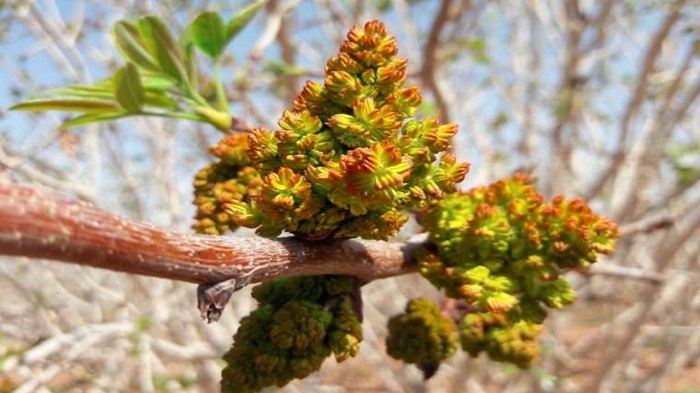
4. Initial Fruit Growth and Greening – Photosynthesis Boost (May)
Post-pollination, trees ramp up photosynthesis for fruit energy. Apply balanced NPK fertilizers, with foliar amino acids and chelated micronutrients. If potassium is low, add mild doses; emphasize leaf health to prevent stress.
Application Method: Fertigate or surface apply, followed by irrigation. Repeat foliar every 10-14 days.
In “on” years, 30% of nitrogen is taken up here, so split applications sync with demand. Ammonium sulfate excels, promoting robust growth without adversely affecting nut size.
5. Shell Hardening Stage – Shell Stabilization and Fill Start (June)
As shells form, prioritize potassium-rich fertilizers with foliar multi-complexes containing calcium, boron, manganese, and zinc. Amino acids aid cell division and reduce fruit competition.
Application Method: Fertigate potassium; foliar micronutrients in suitable hours.
Precautions: Avoid potassium chloride in saline soils; apply potassium gradually to prevent salt accumulation.
This stage builds nut structure, with manure and ammonium applications improving quality in alkaline soils.
6. Kernel Filling Stage – Weight and Quality Enhancement (July-August)
High potassium demand here increases size, weight, and kernel quality. Supplement with calcium and magnesium for tissue stability. Use sulfate of potash; pair with foliar calcium/magnesium and growth stimulants. We suggest you take a look at our guide to the fullness of pistachios.
Precautions: No heavy nitrogen to avoid quality reduction.
Up to 70% nitrogen uptake occurs now in on-years, but focus on potassium; ammonium sulfate can provide light N if needed earlier. Recent trials show 800-1200g ammonium sulfate splits improve yield.

7. Pre-Harvest Fertilization – Preparation for Splitting and Shelf Life (Late August-September)
Near harvest, aim for full kernels, high splitting rates, and post-harvest quality. Reapply potassium to delay aging.
Application Method: Final potassium doses via fertigation; foliar in cool times.
In Arizona, this aligns with prime picking season, ensuring nuts meet market standards.
8. Post-Harvest Fertilization – Recovery for Next Season (September-October)
After harvest, replenish reserves for root regrowth and winter prep. Mild nitrogen (e.g., ammonium sulfate) rebuilds proteins; foliar fruit-set mixes strengthen next-year buds. Add humics and organics for soil recovery; light calcium boosts cold resistance.
For young trees, apply 1 lb of ammonium sulfate split in March and June.
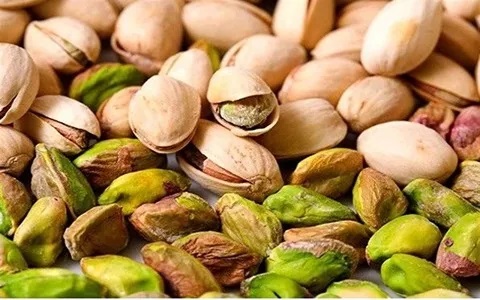
The Critical Role of Soil Testing in Pistachio Fertilization
No program is complete without soil analysis; it’s the foundation for precision agriculture. Tests reveal deficiencies, excesses, pH, and salinity (EC), tailoring applications to your orchard’s needs. In the Middle East, where pH often exceeds 8.0, this prevents long-term issues like nutrient lockup.
Why Test?
- Detect Imbalances: Identifies low zinc or high salts.
- Select Optimal Fertilizers: Choose ammonium sulfate over urea for acidic benefits in alkaline soils.
- Save Costs: Avoid over-application.
- Boost Yield and Quality: Targeted nutrition increases performance.
- Prevent Soil Degradation: Monitors trends like salt buildup from repeated urea use; prompts corrections like sulfur additions.
Test annually, sampling from the root zone. Integrate with leaf analysis for comprehensive insights.
Additional Insights: Sustainable Practices and Ammonium Sulfate Benefits
To reach sustainable yields, incorporate new innovations like AI-guided irrigation and crop sensors for precise fertilizer timing. In the Middle East, focus on salt-tolerant cultivars and organic amendments.
Ammonium sulfate shines in pistachio fertilization: It regulates pH, enhances micronutrient uptake, and supports drought resistance; key for global growers. It improves nut quality when applied with manure and iron in alkaline soils. For injection in irrigation systems, it’s soluble and effective.
